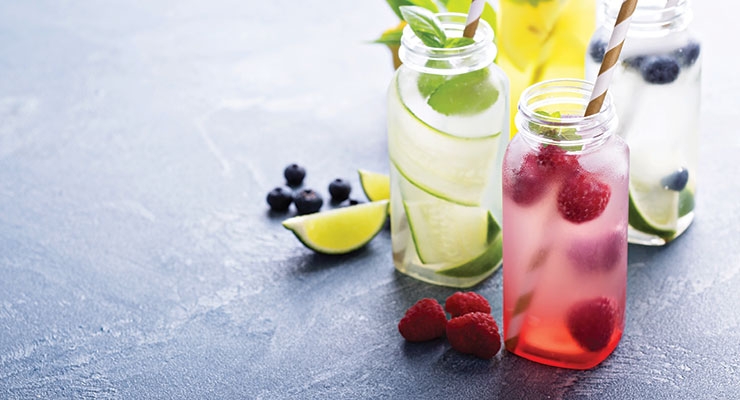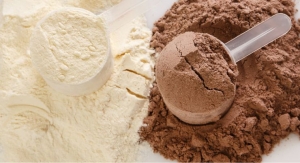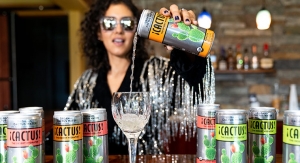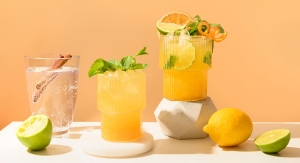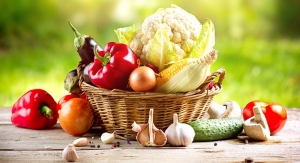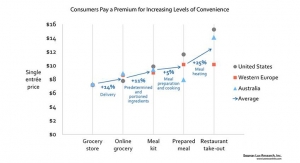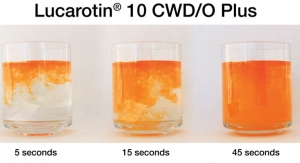By Sean Moloughney, Editor06.02.17
Taste is an essential component of foods, beverages, and supplements for both consumers with discerning palates who live to eat, and those who simply eat to live.
There are a multitude of factors that affect how people perceive flavor from a sensory point of view, and understanding these elements will help companies when developing products, including fortified foods and ready-to-drink beverages.
“Consumers today are complex and sophisticated, said Luis Tanaka, technical director, North America, Canada-based Foodarom Group. “They may choose what they eat and drink based on many different criteria. For example, to mention a few: flavor, color, appearance, packaging, branding, marketing positioning, image, perception, mood, labeling, additives, serving size, price, availability, calories, health and nutritional claims, etc.”
The first elements, flavor and color, play enormous roles in influencing consumer preferences, according to Suzanne Johnson, vice president of research and development, Mother Murphy’s Laboratories, Inc., Greensboro, NC. “Today’s consumers are very conscious of the way food looks and tastes. The culinary world has brought us new foods and restaurants that care about the presentation of food and the way food looks on the plate. These concepts have also influenced all sectors of the food industry. If food does not look fresh and appealing, and does not taste delicious, consumers will not like them.”
The customer experience with food and beverages involves all five senses, noted Kip Murphy, marketing manager, Virginia Dare, Brooklyn, NY. “Our brains have come to expect alignment between certain colors and flavors. Consumers wouldn’t expect a purple beverage to taste like an orange or vice versa. Colors influence the taste expectations for food and beverage. The two complement each other.”
Flavor is a primary reason why people opt for certain foods, beverages, and dietary supplements, said Cynthia Lipka, senior flavorist, Prinova USA, Carol Stream, IL. “They may try it once, but if it tastes awful, then they aren’t readily going back for more. Color sends the initial signal to the brain about what you are going to have. If you see something yellow, you want that to jive with the expected or anticipated flavor such as lemon or banana—you would not expect a chocolate flavor.”
The bottom line is that food products must look good and taste great to have any chance of success, said Mr. Tanaka. “Regarding color, people start screening and choosing based on what they see. More visually attractive food and beverage products have higher chances of being selected. If a product doesn’t taste good, most probably we will not consume it again. It’s as simple and straightforward as that.”
Natural Drive
Increasing demand for healthy and clean label products have compelled product developers to formulate with natural flavors and colors, noted Megan Trent, marketing representative, Gold Coast Ingredients, Commerce, CA. “Consumers are seeking healthier products with simple ingredients statements. As consumers demand fewer artificial ingredients, companies seek natural coloring agents as substitutes.”
Increasingly, companies are looking for organic, non-GMO, natural and allergen-free ingredients to meet specific product and labeling restrictions, she continued. “Gold Coast Ingredients keeps up with the natural and organic trends by consistently formulating exclusive flavors and colors for our customers that meet their specifications and desired flavor profiles.”
The shift toward natural flavors and colors stems from the overall trend for clean labeling, Mr. Murphy said. “Consumers are demanding increased transparency in their products and want to recognize the ingredients used—even the coloring. Companies choose natural colors over synthetic to meet customer demands and adhere to regulations. If they want their product listed as organic or all-natural, synthetic colors may prevent them from making those claims.”
Brittany Blanco, R&D team lead, San Joaquin Valley Concentrates (SJVC), Fresno, CA, agreed that more consumers are looking for ways to eat healthier, which means understanding all ingredients in the products they buy. “The clean label trend is here to stay as larger companies continue to switch from synthetic to natural and create new brands or product lines. The demand will continue to influence suppliers to create solutions and use innovative raw material sources.”
Awareness of phytonutrients and antioxidants has also helped drive use of naturally colorful foods, said Mother Murphy’s Ms. Johnson. “These colorful nutrients such as carotenoids, lycopene, zeaxanthin, and resveratrol are now shown to have important health benefits such as cancer prevention, vision preservation, and cardiovascular health to name a few. Today’s consumers are more aware of these benefits and this knowledge is driving the demand for naturally colorful foods.”
As consumers analyze product labels, looking for natural sources and fewer ingredients overall, artificial colors are on a growing list of ingredients that consumers do not want to see, she added. “The clean label movement is driving this trend toward labels with fewer artificial-sounding ingredients. Natural colors are thought to be safer by the public. The perception that certain artificial colors are associated with health and behavioral issues for children has further made most consumers skeptical of the safety of artificial colors.”
Prinova’s Ms. Lipka also said consumers believe natural is better than synthetic and companies are answering the call with reformulations. “There was a study in the United Kingdom about 10 years ago which had linked a few FD&C colors to hyperactivity in children. As a general rule, the public feels that natural is better than synthetic. In the past, people moved away from natural to get products that were more shelf-stable. Since those products were standardized in that way, consumers didn’t have to go to the grocery store daily for fresh items.”
Supplements also require extra attention as they carry off-notes not normally associated with food, she added. “Flavor has to work doubly hard to get over those hurdles to make the product palatable. Color is also used to enhance products that lose color due to processing.”
Foodarom’s Mr. Tanaka agreed that consumers perceive natural products to be better, healthier, cleaner and greener. “In response to that perception, food manufacturers are shifting more and more towards the use of natural ingredients. Our clients are always looking for outstanding and memorable flavors that will be their unique ‘signature.’ That’s our mission and our main contribution to their food and drink products.”
A Colorful Experience
Consumers eat with their eyes first, according to Nick Lombardo, applications scientist at Flavorchem Corporation, Downers Grove, IL. “Color plays a role in selecting foods that are safe and nutritious for us to consume. Consumers expect to see a color that is both appropriate and attractive to eat. Flavor is crucial in the palatability of a product. A flavor must deliver an experience that keeps consumers craving more.”
Christiane Lippert, head of marketing (food), Lycored, said the company’s research has found that consumers experience a “feel-good factor” from buying naturally colored products. “Our sense of sight, and therefore the visual effect of color is one the first impressions affecting the decision to purchase a product. The shade or intensity of the color itself can also impact perception of acceptability, pleasantness, naturality or sweetness. To quote Charles Spence of Oxford University: ‘Color is the single most important product-intrinsic sensory cue when it comes to setting people’s expectations regarding the likely taste and flavor of food and drink.’”
Companies are increasingly switching from artificial to natural in response to consumer demand. “That’s partly because of growing concern about behavioral problems in children caused by synthetic colors. Last year, the Center for Science in the Public Interest warned that the condition of some children with ADHD ‘may be exacerbated by exposure to a number of substances in food, including, but not limited to, synthetic food colors.’”
Consumers connect specific colors to certain flavors, according to Ms. Trent, of Gold Coast Ingredients. “Have you ever tried a blue colored product that was flavored strawberry? Or a green colored product that was flavored blueberry? If consumers see a blue colored product, they will expect to taste blue raspberry or blueberry, just like if they picked up a green product, consumers expect to taste green apple.”
In addition, colors enhance the perception of “freshness,” she said. “Fresh strawberries are rich in red color and a fresh banana peel is rich in yellow color. Consumers would most likely not relate a brown colored product to fresh banana taste.”
Colors can also influence consumer perception of tartness or creaminess. “For example, when consumers see a bright green colored product, do consumers perceive it as an acidic product or a creamy and indulgent product? The same rationale goes for other colors such as brown. Consumers will most likely perceive brown colored products as creamy and indulgent,” Ms. Trent noted.
SJVC’s Ms. Blanco also said that when consumers evaluate products, color makes a critical first impression. “It is very important for companies to match the color of a product to the flavor. SJVC’s technical staff is available to provide custom colors to achieve matches to hue and shade targets.”
Confronting Challenges
Many natural colors are not as stable in foods, according to Ms. Johnson, of Mother Murphy’s. “From a regulatory perspective, colors get tricky because if any color is added to a flavor (natural or artificial) the flavor is considered artificially colored. For instance, if beet extract is added to a natural strawberry flavor, it is considered artificially colored because the color did not come from strawberries. From a consumer perspective, this is counterintuitive. How can a natural color make something artificially colored?”
Colors from vegetable sources are more stable than ones from fruit sources, according to Ms. Blanco. “San Joaquin Valley Concentrates has addressed the issue of color stability if using a color from fruit is desirable or required. SJVC makes all of its fruit-based colors from the Rubired grape. Rubired grapes have a unique anthocyanin molecular structure that provides protection against oxidation, polymerization, and color degradation. Their unique molecular structure makes them more stable than other fruit based colors, including grape skin extract.”
Colors from natural sources are less concentrated in color than synthetic colors, she added. Companies that use synthetic colors are used to a much lower dosage level than what is needed when formulating with colors from natural sources. “Spray dried colors are typically more concentrated than liquid versions and can help reduce the amount of color needed when formulating with colors from natural sources. However, these colors contain a carrier (e.g., maltodextrin), which has to be taken into account during formulation.”
SJVC produces dry colors (crystal colors) that are dried using a patented drying technology, she added. “These colors do not contain any carriers so they are 2-5 times more concentrated than their liquid counterparts and more concentrated than spray dried colors. They can be used at much smaller dosage levels, are easier to use, and produce less dust during handling.”
Colors from natural sources (when in liquid form) also require refrigeration as opposed to the ambient storage of synthetic colors. “SJVC’s crystal colors can be stored at ambient temperatures for 5 years. Using crystal colors in place of liquid colors saves money on refrigerated transportation and storage.”
One of the biggest challenges is the availability of natural color sources that are sufficiently resilient to the rigors of processing conditions, said Lycored’s Ms. Lippert. “At Lycored, we have developed liquid dispersions and emulsions that are particularly stable to all of these conditions. For example, our recent research comparing Red 3 or Eryothrosine to our Tomat-O-Red R and Tomat-O-Red RP offerings in colored and flavored dairy drinks found that our natural colors outperformed the synthetic Red 3 for withstanding UHT processing and both UV light and heat stability. Another issue is finding natural colors and flavors that are vegan, kosher and halal acceptable. Carmine, for example, is none of these due to its source from beetles. It is also very prone to migration or bleeding in applications such as fruit preparations in yogurt, or coating on products such as surimi.”
The availability, quality, purity and price of natural ingredients depend on variable factors such as weather conditions, yields, crops or diseases, according to Mr. Tanaka. “The natural status of flavors and colors must be properly certified by the relevant authorities. There are also other sub-classifications such as: organic, biologic, non-GMO, pesticide free, vegan, etc. Therefore, the documentation process can be complex and it may take some time before natural flavors and colors are approved for their use.”
The supply and availability of natural ingredients have improved tremendously in the last few years, he added. “The natural trend will not disappear anytime soon and we expect more availability of natural ingredients, but also more complexity and sophistication in the certifications.”
Virginia Dare’s Mr. Murphy said natural colors are less stable, which can lead to changes over time. “They also may not hold up as well during formulation or processing. The example of cereal is a good one. Many brands shifted to natural colors and the end result caught a lot of consumers off guard. The cereals were not as appealing to children anymore because the vibrant, fun colors they were used to were no longer part of the experience.”
As technology improves, overcoming challenges with natural colors and flavors will become less difficult, he added. “Virginia Dare helps our customers overcome taste challenges every day. Our range of natural flavors as part of our Taste Foundations platform gives our customers an extensive portfolio of options to achieve the taste they desire in their finished product. Similarly, our masking flavors in our Taste Collaborations platform helps customers neutralize off-notes that may overwhelm natural flavors and instead let that characterizing flavor shine.”
Flavorchem’s Mr. Lombardo said product developers need to accept that some natural colors will not deliver the intensity that synthetic colors will. “If a one for one replacement is desired, then cost is certainly a challenge. Another challenge is flavor. Some natural colors will impart a vegetative, earthy, or cabbage flavor if they are used too high in a product.”
Natural colors also pose many chemical and physical challenges depending on the product. “Curcumin, found in turmeric is light sensitive and fades rapidly,” he noted. “Correct packaging needs to be considered for light sensitive colors. Anthocyanins are affected by pH and will change color dramatically from purple to bright red as you move down the pH scale. Heat has an effect on many natural colors in baked goods.”
Availability of the full color spectrum is also an issue. “Blue and green can be some of the most challenging colors to achieve simply due to the fact that we only have spirulina to give us a blue hue. Natural colors are very application specific and need to be tested to see what will work best for your product.”
For both natural colors and flavors, keeping price desirable for consumers presents a challenge for product developers, said Ms. Trent. “Natural components and other raw materials can fluctuate in cost. Ingredients might be scarce or not be available in natural form. Since each product is unique, these challenges just take a few extra steps and R&D time. Often times, flavor chemists need to replicate flavor components using a blend of other natural ingredients to complete the flavor profile and/or spend additional time adjusting natural color usage levels.”
From a formulation point of view, synthetic colors are easiest to work with, according to Prinova’s Ms. Lipka. “There is virtually an unlimited array of water-soluble colors that are stable over time and work at any temperature and pH. There are more limited sources for natural colors. Natural colors come from vegetables, minerals or animals such as annatto, beets, or cochineal. Cochineal gives a beautiful color that works very well in products, ranging from pink to bright red. But, years ago Starbucks found out how difficult that was for their branding and consumer perception when their customers found out that their Strawberry Frappuccino color came from bugs. Their fans freaked out and the resulting public outcry forced them to remove the coloring agent.”
On-Trend
Trending flavors varies by application, according to Mr. Murphy, but overall Virginia Dare has seen more exotic flavors become the norm. “Customer palates are evolving and craving a new sensation. Sweet/spicy flavor combinations can be found across multiple food and beverage applications. Flavors with positive health connotations—like ginger, honey, green tea, and acai—are also popular.
According to Phil Houillion, senior flavorist, Mother Murphy’s, vanilla, chocolate, coffee, orange, lemon, lime, strawberry, apple, raspberry, etc., will always have their place at the top. “Many companies will blend these flavors with something more exotic like mango or passionfruit, which are themselves becoming more mainstay.” Ultimately, he added, “people are curious to try new and different flavor types, especially if it exists naturally somewhere in the world.”
Mr. Lombardo predicted that cascara, the fruity skin that covers coffee beans will gain interest. “Coffee farmers typically toss the spent skins into the compost heap, but Ethiopia has been drying and making tea out of them for many years. The American market was formally introduced to cascara through the form of a limited time offer of cascara latte by Starbucks.”
Gold Coast Ingredients’s Ms. Trent noted that some flavor trends have simplified to nature’s “healthy” ingredients such as honey, maple, domestic and exotic fruits, vegetables, nuts, coffee, tea and floral flavors. “As medicinal and functional health trends escalate, we are also seeing an increase in flavors with herbal and spice characteristics.”
Prinova’s Ms. Lipka noted on-trend flavors include floral blends with fruit flavors such as blueberry, lavender or strawberry lychee rose. “We also see requests for indulgent flavor such as dessert flavors for nutritional supplements.”
Apart from healthier, natural, nutritional and convenient products, Foodarom’s Mr. Tanaka noted a trend toward beauty, indulgent and more personalized, unique or exotic products. “Consumers are more adventurous than ever, and they want bold, distinctive tastes. We will see a significant increase in botanical inspired flavors. The addition of herbal/botanical flavors help create a healthy halo around foods and beverages and create a less sweetened profile. The traditional source of natural ingredients will continue to be Mother Nature, or in other words, fruits, plants and animals. With many recent advances in research and development in the biology related fields, there is an interesting potential in the use of microorganisms and enzymes for obtaining natural ingredients. Technologies involving enzymatic processes and microorganisms have a promising future for the flavor and color industries.”
There are a multitude of factors that affect how people perceive flavor from a sensory point of view, and understanding these elements will help companies when developing products, including fortified foods and ready-to-drink beverages.
“Consumers today are complex and sophisticated, said Luis Tanaka, technical director, North America, Canada-based Foodarom Group. “They may choose what they eat and drink based on many different criteria. For example, to mention a few: flavor, color, appearance, packaging, branding, marketing positioning, image, perception, mood, labeling, additives, serving size, price, availability, calories, health and nutritional claims, etc.”
The first elements, flavor and color, play enormous roles in influencing consumer preferences, according to Suzanne Johnson, vice president of research and development, Mother Murphy’s Laboratories, Inc., Greensboro, NC. “Today’s consumers are very conscious of the way food looks and tastes. The culinary world has brought us new foods and restaurants that care about the presentation of food and the way food looks on the plate. These concepts have also influenced all sectors of the food industry. If food does not look fresh and appealing, and does not taste delicious, consumers will not like them.”
The customer experience with food and beverages involves all five senses, noted Kip Murphy, marketing manager, Virginia Dare, Brooklyn, NY. “Our brains have come to expect alignment between certain colors and flavors. Consumers wouldn’t expect a purple beverage to taste like an orange or vice versa. Colors influence the taste expectations for food and beverage. The two complement each other.”
Flavor is a primary reason why people opt for certain foods, beverages, and dietary supplements, said Cynthia Lipka, senior flavorist, Prinova USA, Carol Stream, IL. “They may try it once, but if it tastes awful, then they aren’t readily going back for more. Color sends the initial signal to the brain about what you are going to have. If you see something yellow, you want that to jive with the expected or anticipated flavor such as lemon or banana—you would not expect a chocolate flavor.”
The bottom line is that food products must look good and taste great to have any chance of success, said Mr. Tanaka. “Regarding color, people start screening and choosing based on what they see. More visually attractive food and beverage products have higher chances of being selected. If a product doesn’t taste good, most probably we will not consume it again. It’s as simple and straightforward as that.”
Natural Drive
Increasing demand for healthy and clean label products have compelled product developers to formulate with natural flavors and colors, noted Megan Trent, marketing representative, Gold Coast Ingredients, Commerce, CA. “Consumers are seeking healthier products with simple ingredients statements. As consumers demand fewer artificial ingredients, companies seek natural coloring agents as substitutes.”
Increasingly, companies are looking for organic, non-GMO, natural and allergen-free ingredients to meet specific product and labeling restrictions, she continued. “Gold Coast Ingredients keeps up with the natural and organic trends by consistently formulating exclusive flavors and colors for our customers that meet their specifications and desired flavor profiles.”
The shift toward natural flavors and colors stems from the overall trend for clean labeling, Mr. Murphy said. “Consumers are demanding increased transparency in their products and want to recognize the ingredients used—even the coloring. Companies choose natural colors over synthetic to meet customer demands and adhere to regulations. If they want their product listed as organic or all-natural, synthetic colors may prevent them from making those claims.”
Brittany Blanco, R&D team lead, San Joaquin Valley Concentrates (SJVC), Fresno, CA, agreed that more consumers are looking for ways to eat healthier, which means understanding all ingredients in the products they buy. “The clean label trend is here to stay as larger companies continue to switch from synthetic to natural and create new brands or product lines. The demand will continue to influence suppliers to create solutions and use innovative raw material sources.”
Awareness of phytonutrients and antioxidants has also helped drive use of naturally colorful foods, said Mother Murphy’s Ms. Johnson. “These colorful nutrients such as carotenoids, lycopene, zeaxanthin, and resveratrol are now shown to have important health benefits such as cancer prevention, vision preservation, and cardiovascular health to name a few. Today’s consumers are more aware of these benefits and this knowledge is driving the demand for naturally colorful foods.”
As consumers analyze product labels, looking for natural sources and fewer ingredients overall, artificial colors are on a growing list of ingredients that consumers do not want to see, she added. “The clean label movement is driving this trend toward labels with fewer artificial-sounding ingredients. Natural colors are thought to be safer by the public. The perception that certain artificial colors are associated with health and behavioral issues for children has further made most consumers skeptical of the safety of artificial colors.”
Prinova’s Ms. Lipka also said consumers believe natural is better than synthetic and companies are answering the call with reformulations. “There was a study in the United Kingdom about 10 years ago which had linked a few FD&C colors to hyperactivity in children. As a general rule, the public feels that natural is better than synthetic. In the past, people moved away from natural to get products that were more shelf-stable. Since those products were standardized in that way, consumers didn’t have to go to the grocery store daily for fresh items.”
Supplements also require extra attention as they carry off-notes not normally associated with food, she added. “Flavor has to work doubly hard to get over those hurdles to make the product palatable. Color is also used to enhance products that lose color due to processing.”
Foodarom’s Mr. Tanaka agreed that consumers perceive natural products to be better, healthier, cleaner and greener. “In response to that perception, food manufacturers are shifting more and more towards the use of natural ingredients. Our clients are always looking for outstanding and memorable flavors that will be their unique ‘signature.’ That’s our mission and our main contribution to their food and drink products.”
A Colorful Experience
Consumers eat with their eyes first, according to Nick Lombardo, applications scientist at Flavorchem Corporation, Downers Grove, IL. “Color plays a role in selecting foods that are safe and nutritious for us to consume. Consumers expect to see a color that is both appropriate and attractive to eat. Flavor is crucial in the palatability of a product. A flavor must deliver an experience that keeps consumers craving more.”
Christiane Lippert, head of marketing (food), Lycored, said the company’s research has found that consumers experience a “feel-good factor” from buying naturally colored products. “Our sense of sight, and therefore the visual effect of color is one the first impressions affecting the decision to purchase a product. The shade or intensity of the color itself can also impact perception of acceptability, pleasantness, naturality or sweetness. To quote Charles Spence of Oxford University: ‘Color is the single most important product-intrinsic sensory cue when it comes to setting people’s expectations regarding the likely taste and flavor of food and drink.’”
Companies are increasingly switching from artificial to natural in response to consumer demand. “That’s partly because of growing concern about behavioral problems in children caused by synthetic colors. Last year, the Center for Science in the Public Interest warned that the condition of some children with ADHD ‘may be exacerbated by exposure to a number of substances in food, including, but not limited to, synthetic food colors.’”
Consumers connect specific colors to certain flavors, according to Ms. Trent, of Gold Coast Ingredients. “Have you ever tried a blue colored product that was flavored strawberry? Or a green colored product that was flavored blueberry? If consumers see a blue colored product, they will expect to taste blue raspberry or blueberry, just like if they picked up a green product, consumers expect to taste green apple.”
In addition, colors enhance the perception of “freshness,” she said. “Fresh strawberries are rich in red color and a fresh banana peel is rich in yellow color. Consumers would most likely not relate a brown colored product to fresh banana taste.”
Colors can also influence consumer perception of tartness or creaminess. “For example, when consumers see a bright green colored product, do consumers perceive it as an acidic product or a creamy and indulgent product? The same rationale goes for other colors such as brown. Consumers will most likely perceive brown colored products as creamy and indulgent,” Ms. Trent noted.
SJVC’s Ms. Blanco also said that when consumers evaluate products, color makes a critical first impression. “It is very important for companies to match the color of a product to the flavor. SJVC’s technical staff is available to provide custom colors to achieve matches to hue and shade targets.”
Confronting Challenges
Many natural colors are not as stable in foods, according to Ms. Johnson, of Mother Murphy’s. “From a regulatory perspective, colors get tricky because if any color is added to a flavor (natural or artificial) the flavor is considered artificially colored. For instance, if beet extract is added to a natural strawberry flavor, it is considered artificially colored because the color did not come from strawberries. From a consumer perspective, this is counterintuitive. How can a natural color make something artificially colored?”
Colors from vegetable sources are more stable than ones from fruit sources, according to Ms. Blanco. “San Joaquin Valley Concentrates has addressed the issue of color stability if using a color from fruit is desirable or required. SJVC makes all of its fruit-based colors from the Rubired grape. Rubired grapes have a unique anthocyanin molecular structure that provides protection against oxidation, polymerization, and color degradation. Their unique molecular structure makes them more stable than other fruit based colors, including grape skin extract.”
Colors from natural sources are less concentrated in color than synthetic colors, she added. Companies that use synthetic colors are used to a much lower dosage level than what is needed when formulating with colors from natural sources. “Spray dried colors are typically more concentrated than liquid versions and can help reduce the amount of color needed when formulating with colors from natural sources. However, these colors contain a carrier (e.g., maltodextrin), which has to be taken into account during formulation.”
SJVC produces dry colors (crystal colors) that are dried using a patented drying technology, she added. “These colors do not contain any carriers so they are 2-5 times more concentrated than their liquid counterparts and more concentrated than spray dried colors. They can be used at much smaller dosage levels, are easier to use, and produce less dust during handling.”
Colors from natural sources (when in liquid form) also require refrigeration as opposed to the ambient storage of synthetic colors. “SJVC’s crystal colors can be stored at ambient temperatures for 5 years. Using crystal colors in place of liquid colors saves money on refrigerated transportation and storage.”
One of the biggest challenges is the availability of natural color sources that are sufficiently resilient to the rigors of processing conditions, said Lycored’s Ms. Lippert. “At Lycored, we have developed liquid dispersions and emulsions that are particularly stable to all of these conditions. For example, our recent research comparing Red 3 or Eryothrosine to our Tomat-O-Red R and Tomat-O-Red RP offerings in colored and flavored dairy drinks found that our natural colors outperformed the synthetic Red 3 for withstanding UHT processing and both UV light and heat stability. Another issue is finding natural colors and flavors that are vegan, kosher and halal acceptable. Carmine, for example, is none of these due to its source from beetles. It is also very prone to migration or bleeding in applications such as fruit preparations in yogurt, or coating on products such as surimi.”
The availability, quality, purity and price of natural ingredients depend on variable factors such as weather conditions, yields, crops or diseases, according to Mr. Tanaka. “The natural status of flavors and colors must be properly certified by the relevant authorities. There are also other sub-classifications such as: organic, biologic, non-GMO, pesticide free, vegan, etc. Therefore, the documentation process can be complex and it may take some time before natural flavors and colors are approved for their use.”
The supply and availability of natural ingredients have improved tremendously in the last few years, he added. “The natural trend will not disappear anytime soon and we expect more availability of natural ingredients, but also more complexity and sophistication in the certifications.”
Virginia Dare’s Mr. Murphy said natural colors are less stable, which can lead to changes over time. “They also may not hold up as well during formulation or processing. The example of cereal is a good one. Many brands shifted to natural colors and the end result caught a lot of consumers off guard. The cereals were not as appealing to children anymore because the vibrant, fun colors they were used to were no longer part of the experience.”
As technology improves, overcoming challenges with natural colors and flavors will become less difficult, he added. “Virginia Dare helps our customers overcome taste challenges every day. Our range of natural flavors as part of our Taste Foundations platform gives our customers an extensive portfolio of options to achieve the taste they desire in their finished product. Similarly, our masking flavors in our Taste Collaborations platform helps customers neutralize off-notes that may overwhelm natural flavors and instead let that characterizing flavor shine.”
Flavorchem’s Mr. Lombardo said product developers need to accept that some natural colors will not deliver the intensity that synthetic colors will. “If a one for one replacement is desired, then cost is certainly a challenge. Another challenge is flavor. Some natural colors will impart a vegetative, earthy, or cabbage flavor if they are used too high in a product.”
Natural colors also pose many chemical and physical challenges depending on the product. “Curcumin, found in turmeric is light sensitive and fades rapidly,” he noted. “Correct packaging needs to be considered for light sensitive colors. Anthocyanins are affected by pH and will change color dramatically from purple to bright red as you move down the pH scale. Heat has an effect on many natural colors in baked goods.”
Availability of the full color spectrum is also an issue. “Blue and green can be some of the most challenging colors to achieve simply due to the fact that we only have spirulina to give us a blue hue. Natural colors are very application specific and need to be tested to see what will work best for your product.”
For both natural colors and flavors, keeping price desirable for consumers presents a challenge for product developers, said Ms. Trent. “Natural components and other raw materials can fluctuate in cost. Ingredients might be scarce or not be available in natural form. Since each product is unique, these challenges just take a few extra steps and R&D time. Often times, flavor chemists need to replicate flavor components using a blend of other natural ingredients to complete the flavor profile and/or spend additional time adjusting natural color usage levels.”
From a formulation point of view, synthetic colors are easiest to work with, according to Prinova’s Ms. Lipka. “There is virtually an unlimited array of water-soluble colors that are stable over time and work at any temperature and pH. There are more limited sources for natural colors. Natural colors come from vegetables, minerals or animals such as annatto, beets, or cochineal. Cochineal gives a beautiful color that works very well in products, ranging from pink to bright red. But, years ago Starbucks found out how difficult that was for their branding and consumer perception when their customers found out that their Strawberry Frappuccino color came from bugs. Their fans freaked out and the resulting public outcry forced them to remove the coloring agent.”
On-Trend
Trending flavors varies by application, according to Mr. Murphy, but overall Virginia Dare has seen more exotic flavors become the norm. “Customer palates are evolving and craving a new sensation. Sweet/spicy flavor combinations can be found across multiple food and beverage applications. Flavors with positive health connotations—like ginger, honey, green tea, and acai—are also popular.
According to Phil Houillion, senior flavorist, Mother Murphy’s, vanilla, chocolate, coffee, orange, lemon, lime, strawberry, apple, raspberry, etc., will always have their place at the top. “Many companies will blend these flavors with something more exotic like mango or passionfruit, which are themselves becoming more mainstay.” Ultimately, he added, “people are curious to try new and different flavor types, especially if it exists naturally somewhere in the world.”
Mr. Lombardo predicted that cascara, the fruity skin that covers coffee beans will gain interest. “Coffee farmers typically toss the spent skins into the compost heap, but Ethiopia has been drying and making tea out of them for many years. The American market was formally introduced to cascara through the form of a limited time offer of cascara latte by Starbucks.”
Gold Coast Ingredients’s Ms. Trent noted that some flavor trends have simplified to nature’s “healthy” ingredients such as honey, maple, domestic and exotic fruits, vegetables, nuts, coffee, tea and floral flavors. “As medicinal and functional health trends escalate, we are also seeing an increase in flavors with herbal and spice characteristics.”
Prinova’s Ms. Lipka noted on-trend flavors include floral blends with fruit flavors such as blueberry, lavender or strawberry lychee rose. “We also see requests for indulgent flavor such as dessert flavors for nutritional supplements.”
Apart from healthier, natural, nutritional and convenient products, Foodarom’s Mr. Tanaka noted a trend toward beauty, indulgent and more personalized, unique or exotic products. “Consumers are more adventurous than ever, and they want bold, distinctive tastes. We will see a significant increase in botanical inspired flavors. The addition of herbal/botanical flavors help create a healthy halo around foods and beverages and create a less sweetened profile. The traditional source of natural ingredients will continue to be Mother Nature, or in other words, fruits, plants and animals. With many recent advances in research and development in the biology related fields, there is an interesting potential in the use of microorganisms and enzymes for obtaining natural ingredients. Technologies involving enzymatic processes and microorganisms have a promising future for the flavor and color industries.”

